Text
assignment one progress
hello finale sem
case study / key research works
interviewing two special humans
empathy mapping
lexus crit session
code prototyping
creative workflows
the knitty gritty
after effects newbie
2 notes
·
View notes
Text
the space element to all of this
Space, Image and Sound. I've done some image prototyping, I've explored different types of sound and how to layer the. Today's focus is on space. As I mentioned in previous blogs, I have excellent access to a mediation studio, and I want to utilise that to the best of my ability.
This advantage allows me to use the actual photograph content of SOMM for my image prototypes.
Here are my current mock-ups of how I'd imagine the installation would look like. The circle image I used was from my prototyping of the idea documented here for my BCT paper.

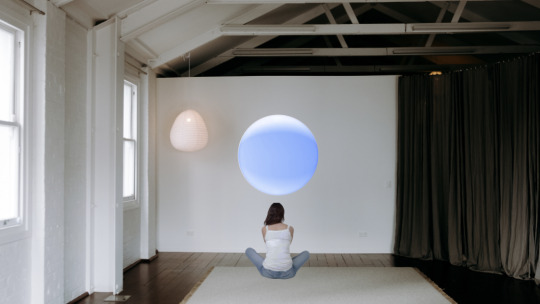

My low fidelity prototype sketches inspired the layouts. However, I am still questioning if this could be a solo or group experience. I like the idea of not being large and appealing to a group but wonder if my users will be distracted by the users around them if I somehow made this a collaborative tool.
I wanted to get a better understanding of how this would feel in person. Finally! after a long wait of covid delivery delays, my very on-trend sunset lamp arrived. The second I saw this advertised, I had to purchase it as it encapsulated the aesthetic and vibe I was keen for my project to entail.
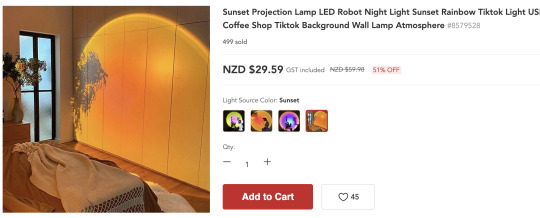

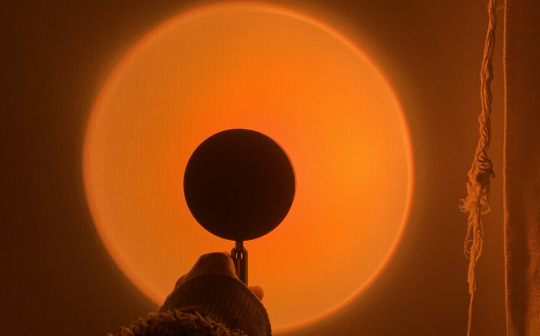
So this evening, I set up my lamp and began a short 5-minute mediation in front of it. Maybe I'm biased, but I loved it. The gradient of the colours was calming. The brightness wasn't too overwhelming, and I could imagine the circles moving with my breath.
3 notes
·
View notes
Text
version two (tibetan sound bowl)
I created this second version inspired by my learnings from tibetan sound healing. I found these sounds online, but make sure to include all 4 of the tibet bowl sounds. These are range in size and depth with result in different vibrations and acoustics.
While I have not yet experiences a sound healing class in person I have booked myself in next week for an online class by a teacher in Auckland. I don't think my youtube experience really cut it.


0 notes
Text
version one (synthesizer calmer)
This is version one for my space, image and sound class. Taking my learnings from synthesizer recordings found online. I am super new to the sounds of this instrument. I was able to play with frequency modulations via garage band which I found super interesting. This is just a 40-second audio clip paired with my animation. In preparation for hand in.
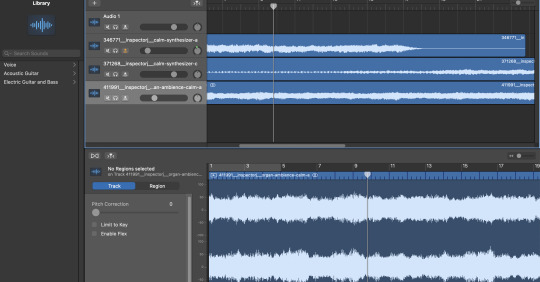
0 notes
Text
after effects newbie
Woohoo! New skill! Today's mission was to create the first version of my animation. I plan to have a circle expand and contract with prompts for the user to either breathe in or breathe out alongside the prompt. Here are my rough sketches, and I want the gradients and colours to be inspired by James Turrel artworks. Blues, greens, and purples moving in smooth transitions. I have scarcely worked with Adobe After Effects before, so this was a bit of a tricky experience. I loaded myself with youtube tutorials to start this one-off. I had a really cool screen recording when I was crafting this all together, but then my mac ran out of storage, and it all deleted. SUPER ANNOYING!
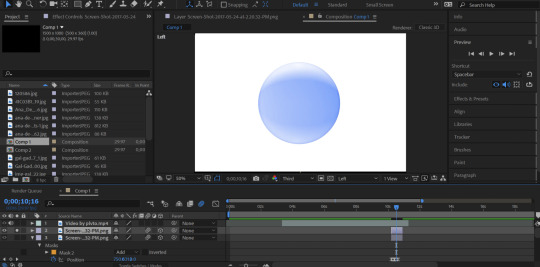
This was my starting point, using gradient and 3D shadows to create a sphere-like shape on the screen. Getting this to expand was pretty tricky. I originally wanted to create a 30-second animation of the circle in a smooth sequence. This ended up as a 1-minute sprint (which I just looped to make longer). I also added some text which will assist my prototyping. I have rendered two versions that have slight breath duration differences and one with and without text. I will simply test these among my at-home bubble to see what their thoughts are.
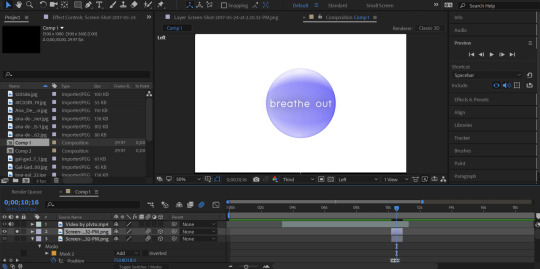
0 notes
Video
youtube
Crystal Bowls Sound Bath (no talking) Sound Healing @ 432Hz
tibetan sound bowl experience
Tibetan singing bowls are thought to have originated from Himalayan fire cults of the 5th century BC and have since been used in various religious ceremonies, including shamanic journeying and meditation.
I have initiated my research with Tibetian singing bowls. Tibetan singing bowls are thought to have originated from the Himalayas from the 5th century BC and have since been used in various religious ceremonies, including shamanic journeying and meditation. Their acoustic behaviour is rationalized in terms of the related dynamics of standing bells and wine glasses. Striking or rubbing a fluid-filled bowl excites wall vibrations and produces sound waves at the fluid surface (Terwagne & Bush, 2011). The acoustics from the bowl's natural vibrational modes can be controlled. Hence, we see these bowls used for classes, where students can immerse themselves in a session of varying frequencies and vibrations. They say sound healing can aid to cure the following.
• Stress • Depression, Anxiety • Chronic Pain • Fibromyalgia • Chronic Fatigue Syndrome • BackPain • Insomnia Treatment methods include: • Addiction • Arthritis • Injuries (speeds up healing and decreases pain) • Emotional Issues • Digestive Disorders.
(Gaynor, 1999)
I plan to attend a sound healing session and ask if I can record the session to adopt into my produced content.
Given the lockdown restrictions, the best I could do right now was source this online. So I embarked on a 20-minute youtube class which was a bizarre experience. I listened to this on my headphones, and I have never felt vibrations from sound in this form before. It was an extraordinary feeling.
I read the comments for the video, and viewers suggested that it wasn't a whole immersional experience and didn't give them the entire experience. I'm sort of nervous to experience this in person...
Terwagne, D., & Bush, J. W. (2011). Tibetan singing bowls. Nonlinearity, 24(8), R51.
Gaynor, M. L. (1999). Sounds of healing. Country Living's Healthy Living.
0 notes
Text
the knitty gritty
We meet again Arduino, can't say I am all too thrilled or confident at this stage! This week I have been on a spiralling tech route trying to figure out the functionality of this device.
I have a couple of ideas and I have been seeking advice from experts via Arduino forums and recently met with Stefan to collaboratively figure this one out!
This was my first idea, having a belt that used a flex sensor to collect data of when the belly expands which then triggers the exhale of the circle graphic.
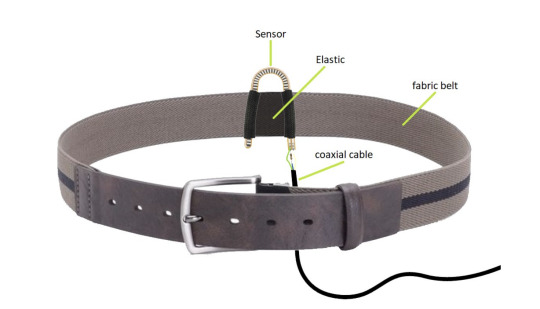
While this is a pretty simple diagram, I could spot an issue where an elastic band would be needed to collaborate the psychical stretch. Another alternative to this would be to use conductive knitting, and this way, I could reduce wiring and potentially reduce noise.
Stefan believes that using conductive knitting, I actually run the risk of increasing noise.
My current situation is trying to find what sensor best fits the purpose of what I'm after. I found this quote "The term sensor is used for the element that uses a natural phenomenon to sense the variable being measured" (Middlehoek & Noorlag, 1982). The Flex sensor is a device capable of changing its resistivity when flexed. In the project, a flex sensor of ¼ may work. It is 5.6cm long. When extended, it has a resistivity of approximately 25kOhm. When flexed, its variation occurs from 45k to 125kOhm.

My flex sensor is on its way from Mexico in the meantime the best I can do it map out the schematics and prepare some code for when I can start to develop this prototype further.
Below is my schematics including resistors (transducers) and the Ardunio. I will use either a coaxial or aux jack cable to transmit the data across.

It is super important for me not to put all my eggs in one basket. In this case, where I am on a bit of standby waiting for my equipment arrival from Mexico, I have had a look to see what else is out there.
I found a tutorial from Instructables, which gave an excellent example of how to complete my brief. Adopting the art of conductive knitting, there is potential to make a breath sensor measured by the stretch of the knitted belt. The idea of this project would wrap around your chest/stomach, and when your chest/stomach expands and contracts, so will the sensor, and consequently, the input data fed to the Arduino. Finally, it would be on me to translate this data into a visual sequence.
I discussed this project with Stefan, and he outlined how this may not be a very accurate way to track breath. Due to the full belt sensitivity, even the smallest movements could impact the data. This is why Stefan helped me construct some code that would only take averages and reduce the noise.
If I solely direct this device to the mediation world, this iteration may work as the body would be in a still position. However, from my earlier research, I was thinking of apple watch compatibles; if I went ahead with this prototype, it would likely be inaccurate/ over-sensitive to the breaths.


Images taken from https://www.instructables.com/DIY-Breath-Sensor-with-Arduino-Conductive-Knitted-/
0 notes
Text
creative workflows
Here you will find and enjoy my current to date Lucid Chart in preparation for hand in one.
I have never completed a creative workflows chart before but referring and tracking along with the flow has been really helpful. In my calendar, I can simply map out my week's intentions and if life happens Lucid makes it super easy to flip and move things over.
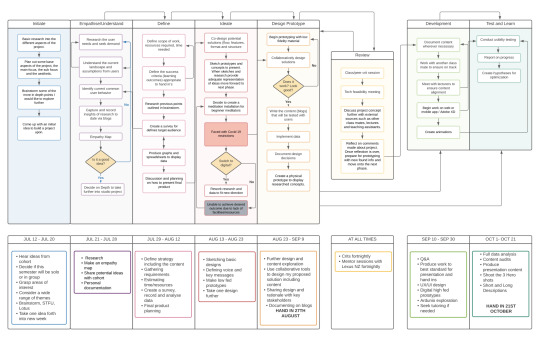
0 notes
Text
code prototyping
I am currently working on a project that allows me to translate respiration rate to a servo. The servo will eventually be integrated into a larger project based on the data obtained by breathing biomechanics. The system has a sensor capable of detecting the extension of the rib cage and converting this information into an electrical quantity. Software embedded in the computer receives the information and converts it into a visual experience.
A key aspect to this project that I knew I needed to get on top of sooner rather than later was my code and physical computing. This is as I have the least amount of experience and the most to learn.
Fortunately, the main piece of this code is very simple, to gather the inputs from my knitted belt readings and gather the differences. This was a simple start documented below. Ignore the name Breathworks my project has since been renamed to Depth.
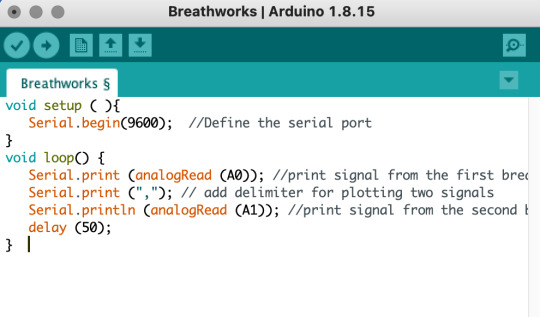
From here, my next move in preparation was to solve an apparent issue regarding the noise and sensitivity likely to be picked up from the device. I met with Stefan to discuss this problem, and he was able to source and explain some code that would calibrate the averages and ensure the last spikes in movements would not interfere too greatly with the visual graphic. A screenshot of part of this code is below.
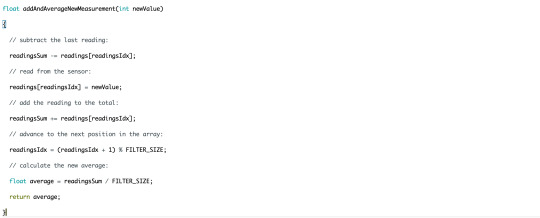
My next stage of code prototyping is to plan how I will manipulate a circle that would decrease and increase in size regarding the data obtained from the device. I used processing to create this circle. I now need to get it corresponding to the given values. This is currently a work in progress.
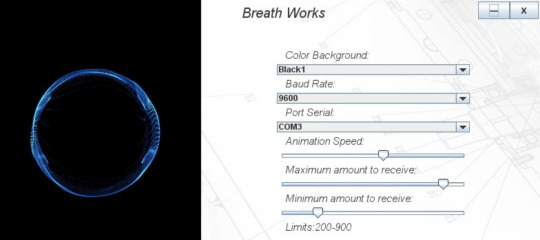

1 note
·
View note
Text
low fed ideation time
I have had a week to research and begin my ideation. At this stage, I have picked up some inspiration from the RedBull data dance night and after the analysis of James Turrell's work. Still, on track to merge technology within the wellness industry, I have a rough idea of a visual sequence a student will observe as a part of their meditation practice. I want to create a visually calming graphic that is lead by the depth of breath. I'm picturing a circle that expands and contracts, indicating that the user takes a deep breath or exhale.
How cool would it be to deep dive into the soundscape world and use chimes, frequencies, traditional bells to support this visual! So - okay, I'm pretty excited by this.



Today I spent making low fidelity prototypes, quite literally my favourite thing to do in the studio. I had great chats with Hannah regarding these interesting formations sitting in front of us. I gave Hannah my wee elevator pitch, and she could see and understand this purpose.
This installation will be an aid to beginner meditation students. It can also act as an anxiety relief practice along with being a potential breath work tool.
I've tried to make these as easy to understand as I could. But with these prototypes, I was able to test eye level, size of screens, multiple users and wall layouts. It was pretty simple to imagine being the little dude and gazing at the screen (or projection?). I got quite a lot out of this exercise, seeing my idea differently and more realistic.
0 notes
Text
lexus crit session




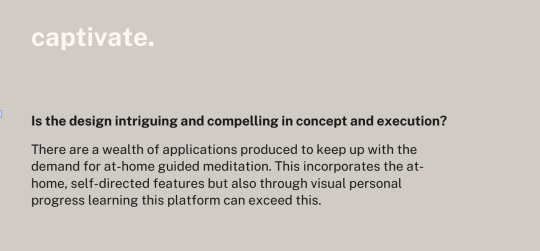
Today was the first day of the LEXUS Crit session. All students enlisted in this provocation did a short 15-minute presentation that explained our ideas and how the proposed idea aligns within the LEXUS criteria. Above is the presentation I prepared.
Key Aspects
- How can the design can enhance the happiness of everyone
- How can the design anticipate an audience
- How is the design innovative
- Is the design captivating
I received some pretty great feedback from this session, with the cohort acknowledging how the tool can be used beyond an introduction to meditation. For example, an anxiety reliever, or breathing practice for athletes, even rehabilitation for smokers. This was super exciting to hear. I also was reminded that the animation can go further beyond a circle contracting and expanding. I can animate shapes, lines, a beach with waves coming in and out. This may appeal to a larger audience, and it could open the device to be more customised again, enticing a larger audience.
Simon and Scott recommended that I looked further into the mobile compatibility of the work. The mobile app is likely to be much more at hand, and the device can be designed in a more modular direction. This makes a lot of sense.
Overall, great day and some things to absolutely note and prototype. Main aspects, the overall animation aesthetic and the further functionality considering the mobile compatibility.
0 notes
Text
case study / key research works
Red Bull Visualization
An installation that straddles the lines of art, science, and technology. I was immediately drawn to this work, why? Because it perfectly encompasses the excitement that new technology and data brings. This shedding a brighter light than the dark and scary picture data and tracking tends to leave on people.
Each guest wore a bracelet integrated with a motion, temperature and sound sensor which fed into an onsite network of receivers which then gathered that guests data which then generated the atmospheres visuals.
Could I incorporate e-textiles into my project, can the use of sensors work amongst the wellness realm? I think YES
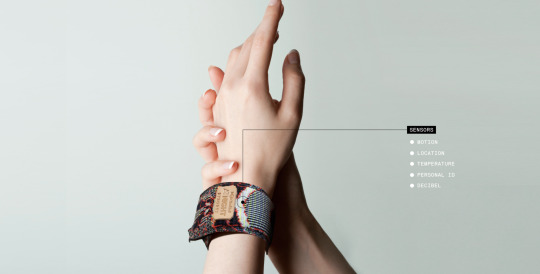
https://player.vimeo.com/external/221893073.hd.mp4?s=a9667505d47408632429b2aafc6bac3a0f66dc32&profile_id=174
TARGET AUDIENCE -The event was attended by Red Bull friends, VIPs, media, music industry experts, and other invited visitors.
SOLUTION - Guests' data visualisations were created and presented in real-time during the event, and a personalised keepsake was given out afterwards.
RESULT - The future of club culture, live events, and data-driven experiences have taken on a new dimension.
My favourite aspect of this project was the personalised data visualisations. Each guest was given a one-of-a-kind, personalised souvenir: a print of their own personal vision based on their ‘night flight.' A one-of-a-kind work of art combining their own real-time sensor data.
All good design leaves a significant memory between the work and the user. If I could incorporate individualisation and bespoke emotions into the work, then I can expect great attraction.
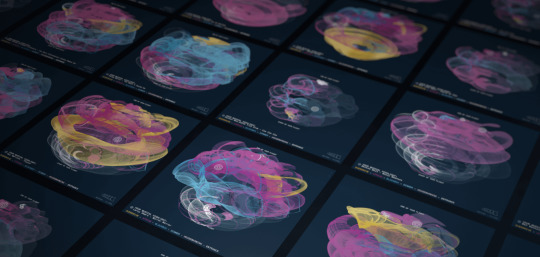
--------------
James Turrel
A lot of people come to art and they look at it, and this is one of the problems in contemporary art, and so they don’t actually enter the realm that the artist was involved in. ⎯ James Turrell
The American artist uses actual and artificial light to create mind and eye tricks, evoking amazement that is uncommon in modern art.
I have been reading many reviews and articles on Turrel's work. From my understanding commonly guests find his work out of this world peaceful but at the same time deeply immersive. One can sit for about an hour, as the work completes its cycle.
James Turrell has been using light and space to create effects that are fascinating, confusing, hallucinogenic, soothing, contemplative, and slowly defamiliarizing since the 1960s.
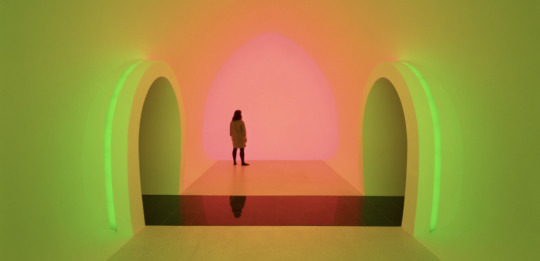
James Turrell: A Retrospective spans over 50 years, during which Turrell has created a body of work that is unparalleled in its depth of engagement with light and space as materials capable of immersing the observer in a deeply immersive art experience. Single light projections provide the illusion of a three-dimensional shape in his early work. These frequently take advantage of space's corners.

This is incredibly insightful. I am heavily inspired by Turrel's aesthetic and play with light projections. I see many similarities to the way people have experienced his work and how I would like my users to feel. If my users can acquire a fully immersive, be it through surrounding light projections, I will prototype these principles.
-------------------
Apple Watch: Breathe & Reflect Feature
The newest Apple Watch update added a new Reflect function to the Watch, which can help the wearer optimise their mood throughout the day. In more recent years, Apple has placed a larger focus on health and wellbeing services, with the Breathe app for Apple Watch serving as an example. Apple's Breathe app is a built-in function that has evolved over time and can act as a calming tool for those on the go needing to take a moment to simply breathe and reflect.
When the Reflect option is selected, the wearer is given a short sentence to mull over, such as "consider something you like doing and why it brings you joy," followed by a calming picture that encourages them to breathe quietly while contemplating. The Mindfulness app is meant to promote improved overall wellbeing by establishing positive thinking in its users throughout the day with the aid of both the Breathe and Reflect sessions. This simple addition to something already at hand provides a compelling incentive for Apple Watch owners to upgrade to the newest edition and keep mindful of their day to day.

While something like I am aiming to achieve already exists in probably the most ideal platform (literally at hand). I wonder how I can take this further? Or could I work alongside this application?
0 notes
Text
empathy mapping
After my interviews, I decided to do some empathy mapping to construct a bit of an idea of my audience and further understand who I may be designing for.
I decided on two female profiles, a student who could utilise mediation to help with some recent stress-related panic attacks. She is an introverted creative who just needs more tools to aid her more worrying times especially approaching her final year of High School education.
I learnt that students could be a really great place to test and survey, especially with well-known peaks in youth stress and anxiety rates. Breathing tools and practices are commonly preached to young adults. I wonder if this project should be entirely focused on students?

The second profile I created was a teacher. My inspiration for this character struck after interviewing Michelle. This character is also inspired by a teacher I had in high school.
She is a kind and active woman with mild signs of ADHD. She will go out of her way to better herself and put her well-being first. This is important for my target audience. I would really hate to market to a field of people who are uninterested in a well-being product! This is a unique industry where the market knows themselves and wants to learn and implement good things.
It's pretty amazing when you think about it.
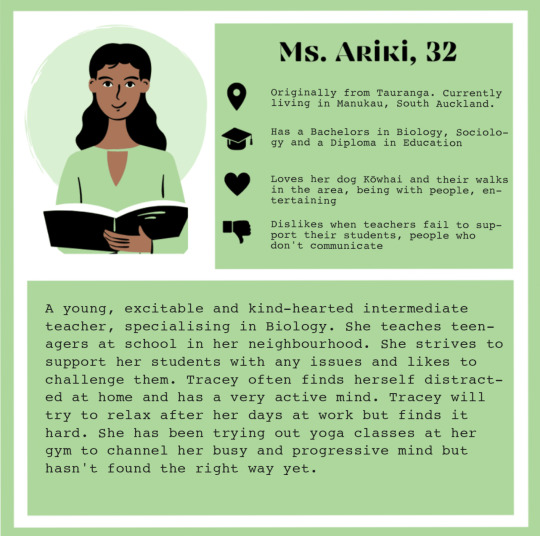
0 notes
Text
interviewing two special humans
I spoke with Kayla Gordinie, the founder of Awhina Wellness, a holistic health coaching community. I asked her about her thoughts of her views if technologies incorporated into the wellness industry. She explained how platforms like Zoom has let her acquire clients from across the country. Also, sound systems like Sonos has been a fun tool to have small classes tune in to the same sounds which support her teaching.
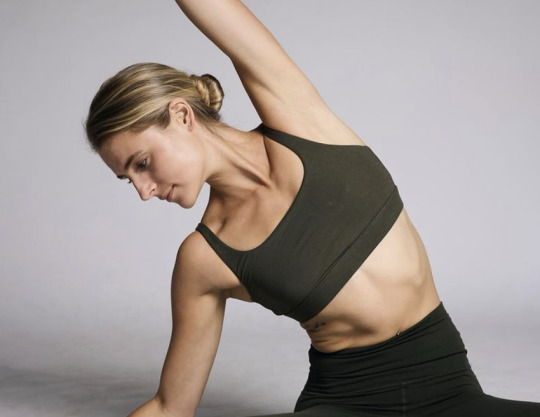
Kayla mentioned that she couldn't see tech going much further, especially in her practice. However, she's aware that many of her clients may not be highly eager to work with phones and screens when they often consider a yoga or sound healing class a screen timeout zone. It is a common conversation of people who find themselves nervous in new tech talks and data capturing. However, many emerging digital artists are changing this tune by making data attractive, beautiful and enticing, rather than the big scary storm painted to the public.
So, I wonder if this project can help reside this. Can data can be seen in a new and exciting light within the meditation school? (that I have brilliant access to).
I conducted another interview through a mutual friend Michelle, who was open to talking about ADHD. Also known as attention deficit hyperactivity disorder, people diagnosed with this mental health disorder experience impulse behaviours and above normal levels of hyperactivity. Michelle has a lot of "trouble with focusing her attention on a single task or sitting for long periods of time" - the two main aspects of meditation.
When I asked her if she has ever tried practising mediation before, she said, "I have always seen and understood the appeal, but I have never experienced that myself. The second I close my eyes, my mind runs wild - unless I'm exhausted". This is an important note. The second the eyes shut, a person with ADHD's mind can get very cloudy. I wonder if Michelle watched a relaxing visual to focus and align with her breathing would that help?
I asked Michelle about her methods to destress, she responded, "The best thing I can do is walk the dog or do something active. It's the best way to distract away from my busy 24/7 mindset. It's really tough when I don't have the energy to do these things though, having a wine and watching dumb television can also do it."
This is another point to delve deeper into, can I combine the attitude of trying to do something active that is also the right amount of 'mind numbing' to be good for you.
Some really interesting interviewees will help with my future ideation and prototyping. I definitely want to test people with ADHD and without ADHD to hear about their experiences with the project.
0 notes
Text
arty field trip
The class of This session was held out and about today. So to spend the morning popping to Auckland Art Gallery, Gus Fisher Gallery and St Paul gallery. All in super proximity to campus - how handy.
The intention for today was not just to see the enticing artworks but see their behinds. For example, how were they installed, how many projectors, where are the power outlets? What equipment was needed to hang that thing there?
This was pretty fun! Wow, as a public viewer popping into these galleries regularly, I was blown away to now see installation mechanics that I had never noticed before. Is this going to tarnish every installation gallery I visit from now on?

My live iPhone notes
- So many cables. Why are all cables black?
- Would painted cables be better hidden?
- Can't spot any power outlets must be behind the walls. - is that expensive to do
- Fluorescent lights are heavy, judging by the amount of support they sit with
- Wires are pretty easy to trip up on if you get close
- This must be so expensive to install
- The walls of these galleries must often get touch ups
- Dust pile up on the furniture piece
- Coloured light bulbs would be so much more evident in a darker room
- Projectors are unseemly hidden but everywhere
- SONOS speakers (search this brand up)
- Headphones for screens don't all work
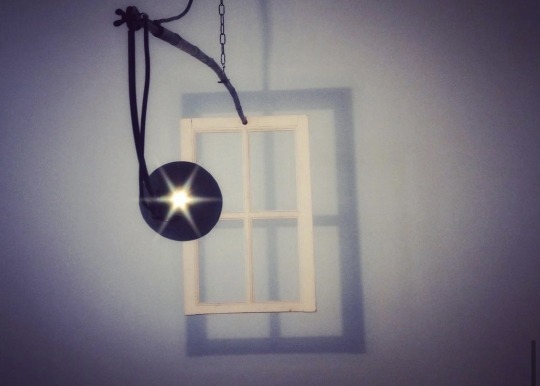

0 notes
Text
introduction of s.i.s.
Space, Image and Sound ... a whole new class that I am incredibly excited for but at the same time nervous as anything! I am well aware that BCT gives students a wealth of opportunities to learn a shit load of skills, and this paper doing that exactly. I am eager to learn more about sound acoustics concerning space and use my visual communications skills in a new realm.
Today's class was a square one idea-generating session. Spending much of the session taking inspiration from Clint and Hannah's hand-picked favourite works. I found it incredibly interesting to understand the career that a space, image and sound installation-ist endeavours upon—pretty epic stuff.
I have picked up a couple of shared examples from the class, which I will expand upon in my next blog.
But here I am with a literal blank page in front of me. What should I create and imaginate?
With my enthusiasm already at a high from this class, I decided to take the brave step of potentially combining my main studio paper and this class. I want to work my current work into this paper, too (I'm really about that total emersion)
Signing this blog off with an I think I will make... 'I think I will design an installation for wellness studio/retreats that incorporates technologies of sort'.
Vague, but okay at this stage.
0 notes
Text
hello finale sem
Hello, final semester!! Goodness me that is so crazy to come to terms with. I spent the remainder of my break finishing my internship with Perfume Playground in perfume design and sales and marketing.
Because I enjoyed the experience so much, I have hopped right back into the pool of work, this time in an entirely new realm. I have made connections with Claire Robbie, a former news presenter and now meditation and wellness expert.
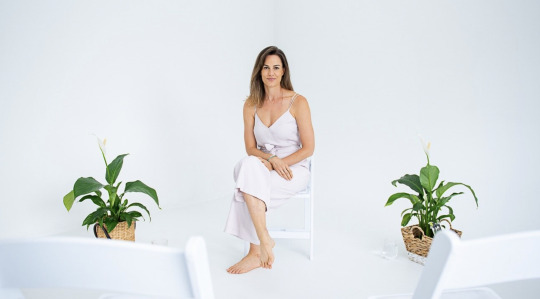
Claire is about to launch a brand new studio on K'road, and I have come on board as her Events/Operations Manager and Stylist. I am so excited about this! I have picked up some excellent skills from Perfume Playground, which I am ready to transfer to an entirely new role.
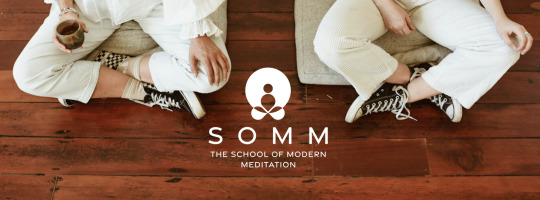
Now in regards to uni, I am in a funny position. The last semester project I consider was strong enough to take further into another semester. I got enticing feedback from the marker's recommended taking it further, too. But I, unfortunately, don't have the same access to perfume resources for experimentation!
I'm now wondering, can I take this new wellness job access and design within this world. It's great that I don't have. a significant wealth of experience and knowledge in this field, therefore just like with my perfume project, I am taking a new world and utterly emerging and absorbing as much as I can from within.
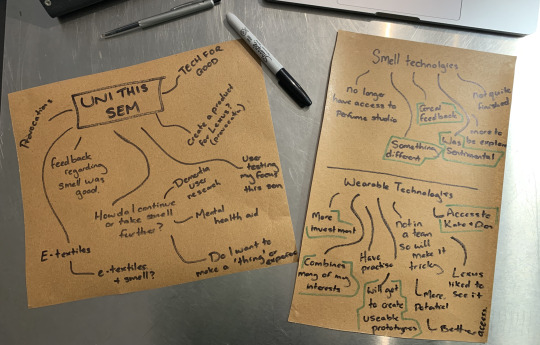
Claire is entirely besotted by this degree and can't believe something fun and experimental exists within the uni world. So I'm thinking how cool it would be to introduce technology into the meditation space. So then, with an utterly blank canvas, I begin to brainstorm ways to introduce tech into the pretty technologically bare space.
Sound installations, acoustic sessions, administration applications, heart rate trackers, apple watch compatibility app, visual installations are all ideas currently circulating in my mind. I am planning to take my learnings from Space, Image, Sound class into this project discovery. Specialising and prototyping within the space I have access to. I would love to incorporate visuals into this project. Across my creative tech time so far, I have made sure to try a new skill set. This semester I need to get back into coding and animations, and if I can tailor the course of this project to work to the advantage of the space I have access to, that would be perfect.
Digging into some research, I discovered a few projects that share similar aspects that I am thinking to analyse and take further.
0 notes